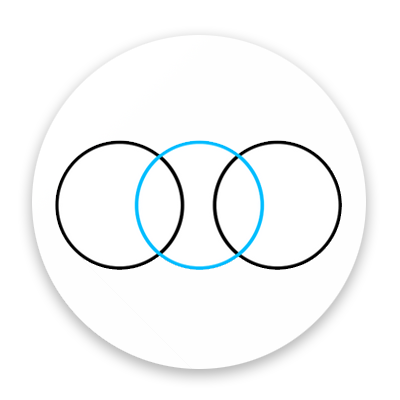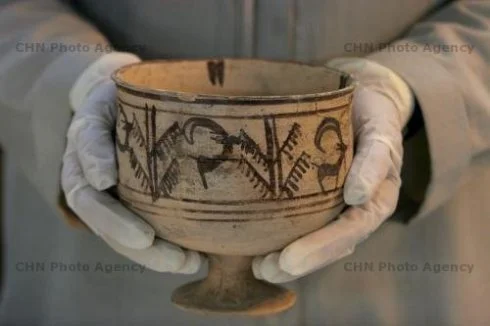‘Birth of Film’
This page contains links, images and video's related to early moving image, 'pre cinema', experiments.
Shahr-e Sūkhté Goblet
An earthen goblet discovered at the site of the 5,200-year-old Burnt City in southeastern Iran, depicts what could possibly be the world's oldest example of animation. The artifact bears five sequential images depicting a Persian Desert Ibex jumping up to eat the leaves of a tree.[2]
‘The earliest known example of animation.’ This five frame animation of a particularly cute Persian desert Ibex feeding on a shrub was found on an earthen goblet at the Shahr-e Sūkhté site in Iran. I always wanted to see how it might look set up as an animation, so I extracted the sequence from picture of the goblet and unwrapped it digitally.
As I was revisiting this page, January 2020, the news of Donald Trump’s threats to target “52 Iranian sites … some at a very high level & important to Iran & Iranian culture, and those targets, and Iran itself, WILL BE HIT VERY FAST AND VERY HARD” were dominating the News.
Cave of Forgotten Dreams
In 2012, French researchers suggested that 'Prehistoric cave artists used cartoon-like techniques to give the impression that their images were moving across cave walls'.
"Sequential Animation: the first Palaeolithic animated pictures" - by Marc Azéma.
Marc Azéma of the University of Toulouse-Le Mirail and artist Florent Rivère claim their remarkable theory is backed up by the discovery that ancient engraved discs were used as thaumatropes - formerly claimed to have been invented in 1825 by astronomer John Hershel. Damien Gayle, Daily Mail, 23/9/2012.
The Origins of 'Persistence of Vision
'The Origins of 'Persistence of Vision' or 'Retention of Image' - the phenomena which, it is often noted can be used to explain how motion pictures work - can be traced back to experiments by Newton, but it became firmly established by Belgian scientist Joseph Plateau in 1829.' http://www.earlycinema.com/technology/zoetrope.html
The thaumatrope, phenakistoscope (1832), zoetrope (1834) and praxinoscope (1877), as well as the common flip book, were early animation devices that produced an illusion of movement from a series of sequential drawings. The basic drum-like form of the zoetrope was created in 1833[3] or 1834 by Bristol based mathematician William George Horner.' Wiki
Why not try making your own Zoetrope?
Horse in Motion - Eadweard Muybridge 1878
Dan Colman in an Open Culture article says 'If you’re looking for the first movie ever made, you can look back to The Horse In Motion, created by Eadweard Muybridge in 1878. Muybridge was asked by Leland Stanford (railroad magnate, California senator, race-horse owner, and eventual founder of Stanford University) to answer a popularly debated question: When a horse trots, do all four hooves leave the ground simultaneously? Muybridge’s stop motion film made it clear that they do.' Link
‘The Horse in Motion and later experiments are not ‘movies’ but they are early photographic sequences, known as chronophotography and can be regarded as early motion picture recordings that could not yet be presented as moving pictures. Since 1878, Eadward Muybridge made hundreds of chronophotographic studies of the motion of animals and humans in real-time, soon followed by other chronophotographers like Étienne-Jules Marey, Georges Demenÿ and Ottomar Anschütz. Usually chronophotography was regarded as a serious, even scientific, method to study motion and almost exclusively involved humans or animals performing a simple movement in front of the camera. Soon after Muybridge published his first results as The Horse in Motion cabinet cards, people put the silhouette-like photographic images in zoetropes to watch them in motion. Most sequences could later be animated into very short films with fluent motion (relatively often the footage can be presented as a loop that repeats the motion seamlessly). (wiki)
THE LUMIERE EXPERIMENTAL FILMS
'One of the first commercial, public showings of a motion picture in France (and made with a celluloid film camera/projector), took place December 28 of 1895 at the Grand Café on the boulevard des Capucines in Paris. The Lumière's used the basement to open their movie theatre known as the ‘Cinematographe Lumière Freres'. A private showing of the machine (as well as experimental films) took place in March of the same year - see below. The device was the Cinematographe (below left & right), and was used in scheduled showings from that point on. It was constructed by Jules Carpentier of the Lumière factory, with Alfred Molteni adding the lamphouse, and had a claw-like mechanism in order to provide the required intermittent pull-down movement of 35mm perforated-celluloid film. The film which had two perforations per frame, was also manufactured by the Lumière business. (Image Source: Smithsonian Institute)' *
'The first of the Lumière private screenings took place on 22 March 1895 in preparation for the public showing in December of that year. Known as Actualités, or 'actuality' films, their repertoire of experimental films amassed to over two thousand by the year 1903.
These films of everyday life added greatly to the popular culture and by early 1896, the Lumières had opened theatres in New York, Brussels, and London, as well as in France, showing their films on the same machine which had taken them, the Cinématographe.
One such film was entitled Arrival Of A Train At La Ciotat Station or, “L'Arrivée d'un Train en Gare de la Ciotat” (right). Subtitled and catalogued as number 653, this short featured members of the Lumière family in the crowd to the right.' *
L'arrivée d'un train en gare de La Ciotat (translated from French into English as The Arrival of a Train at La Ciotat Station, Arrival of a Train at La Ciotat (US) and The Arrival of the Mail Train, and in the United Kingdom the film is known as Train Pulling into a Station) is an 1895 French short black-and-white silent documentary film directed and produced by Auguste and Louis Lumière.
A Brief History of Film
This short video on Youtube gives a good whistle stop overview of a history of film.
Project Happening's animated brief history of film. The documentary ranges from 1500 with Leonardo Da Vinci, to George Eastman in 1888, and concludes in 1895 with the Lumiere brothers, all in less than 5 minutes. Please leave a comment and let us know what you think.







